A deck ranges from 175 square feet (16 square meters) to 260 square feet (24 square meters)., providing space for essential furniture like a bistro dining set and lounge chairs. The purpose of a deck is multifaceted: it serves as an outdoor venue for entertainment, dining, and relaxation. They offer a platform for leisure activities, contributing to physical and mental well-being. Typical deck shapes include rectangular or L-shaped designs, maximizing space and providing access points. Deck color schemes include blue, gray, green, beige, white, red, and brown. Renovating a deck costs between $3,000 (€2,700, £2,300) and $15,000 (€13,500, £11,400), influenced by the size, layout, materials, railings, covering options, landscaping, lighting, and budget constraints. Architect fees for deck renovation range from $1,500 (€1,350, £1,150) to $5,000 (€4,500, £3,800). Redecorating a deck takes 2 to 6 weeks, depending on the project’s scope, size, material availability, and unforeseen challenges. Homeowners struggle with weatherproofing, aesthetic integration, functional layout, material selection, budget balancing, and adherence to safety standards. An architect’s involvement can alleviate these challenges, providing professional expertise and efficient project management.
What is the typical size of a deck?
A typical deck ranges from 175 square feet (16 square meters) to 260 square feet (24 square meters). This allows for fitting essential deck furniture like a bistro dining set, lounge chairs, planters, and a grill. The ceiling height remains open to the exterior. The 175 square foot (16 square meter) to 260 square foot (24 square meter) deck creates outdoor living space for 2-4 people. The average home deck measures 260 square feet (24 square meters) to 380 square feet (35 square meters). The expanded area incorporates comfortable conversation sets, outdoor cabinets, fire pits, and dining tables without congestion. Stair width expands for better circulation. Ceiling height varies based on roofline connections 2-3 stories above the surrounding terrain.
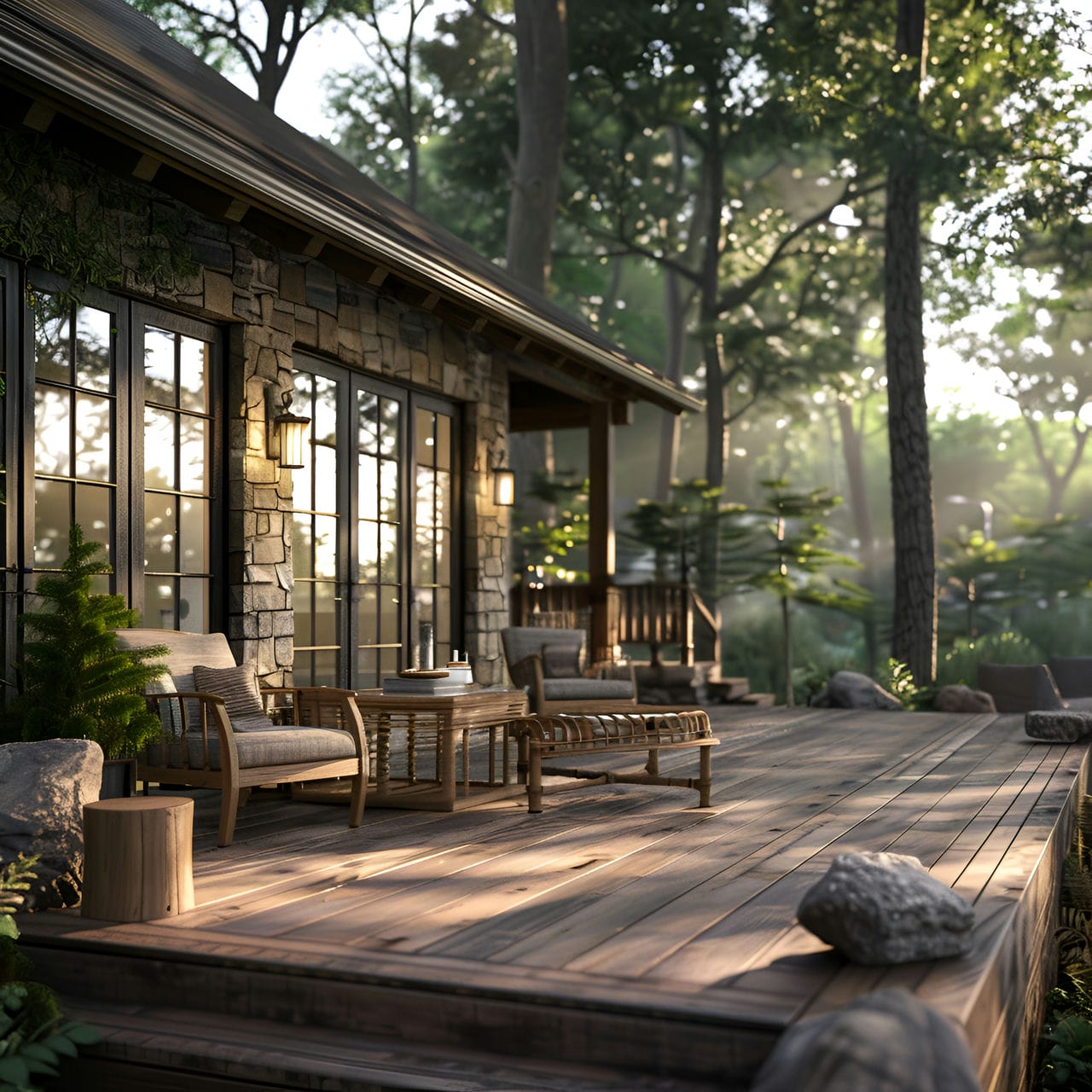
Grand decks in luxury estates open to expanses exceeding 650 square feet (60 square meters). Spacious layouts incorporate ample conversation areas, 12-person+ dining space, buffet stations, stone fireplaces, weatherproof televisions, and proximity to outdoor Kitchens or wet bars. Architectural features like integrated pergolas and covering roofs enclose a portion while the remainder stays exposed. Built-in bench seating and curve-shaped accent walls define the ample footprint.
What is the use and purpose of a deck?
The purpose of a deck is to create a multipurpose entertainment, dining, and relaxation venue. Firstly, a deck serves as an outdoor living space for entertainment, relaxation, dining, or other leisure activities. It provides a comfortable area to enjoy fresh air and nature views while shielding from sun, rain, and other elements. Decks are used for hosting gatherings, parties, barbecues, etc. Secondly, a deck adds flexible outdoor square footage to increase a home’s livable space. Unlike a sunroom addition, basic deck construction has a higher return on investment in terms of increased home value and usable area. Thirdly, decks allow better integration of indoor and outdoor areas for a living space. Fourthly, decks facilitate outdoor time, with physical and mental health benefits like stress reduction and vitamin D absorption. Open-air exposure in a protected setting is both relaxing and invigorating. Lastly, decks are customizable in shape, size, height, railings, and amenities to suit different needs, budgets, and aesthetics.
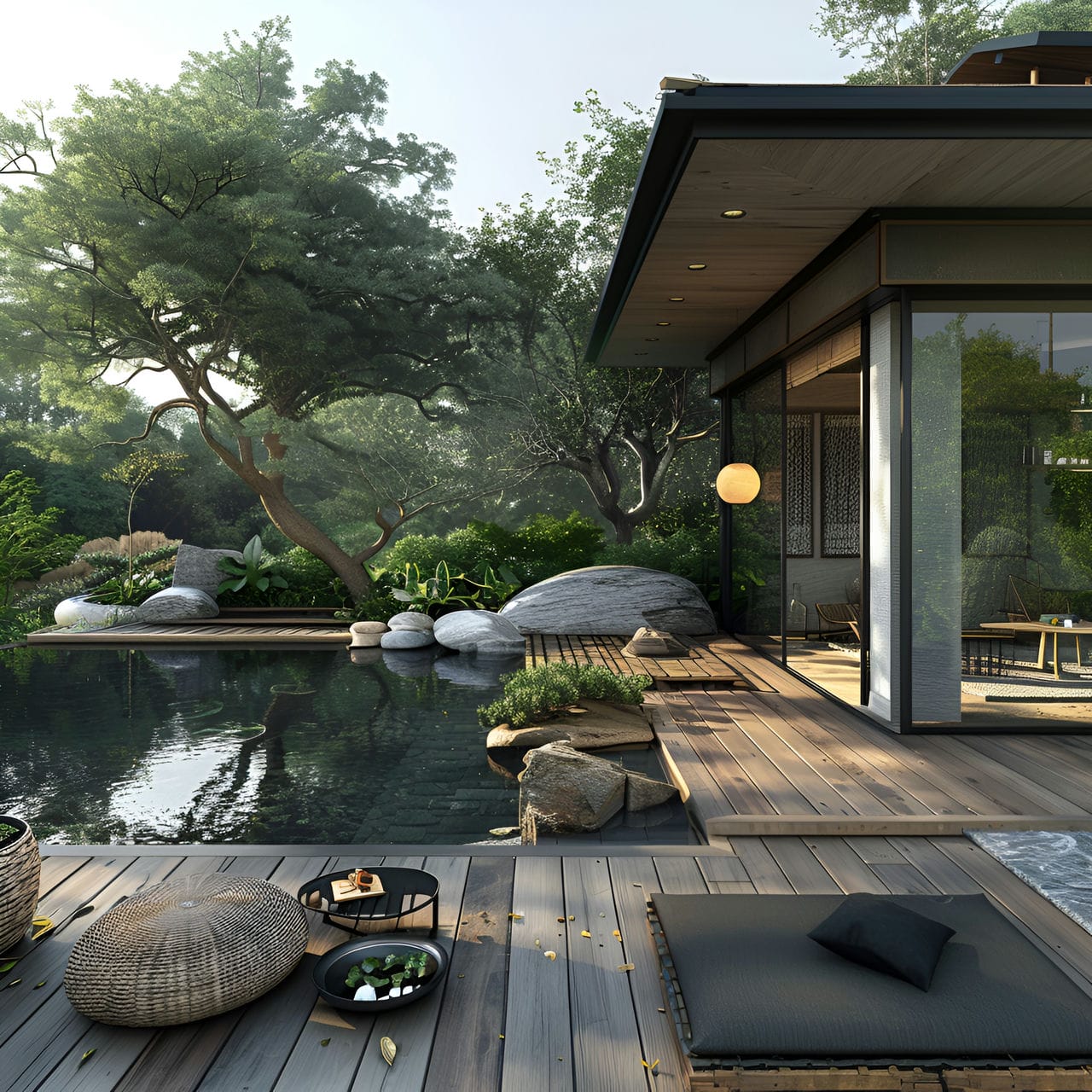
What is the typical shape of a deck?
The typical shapes of a deck rely on a rectangular or L-shaped footprint for space optimization. Rectangular deck blueprints situate the longest wall 50 square feet (4 meters) to 75 square feet (7 meters) parallel to the home rear exterior lines with narrow ends ranging from 30 square feet (2.5 meters) to 50 square feet (4 meters) deep. Identical side lengths ranging from 50 square feet (4 square meters) to 75 square feet (7 square meters) concentrate access stairways centrally while maximizing equal exterior clearance exposure. Some corner properties incorporate custom decks wrapping 90 degrees around a focal outdoor fireplace or dining space. Typical deck foundations remain timeless rectangles and L shapes starting from 50 square feet (4 square meters).
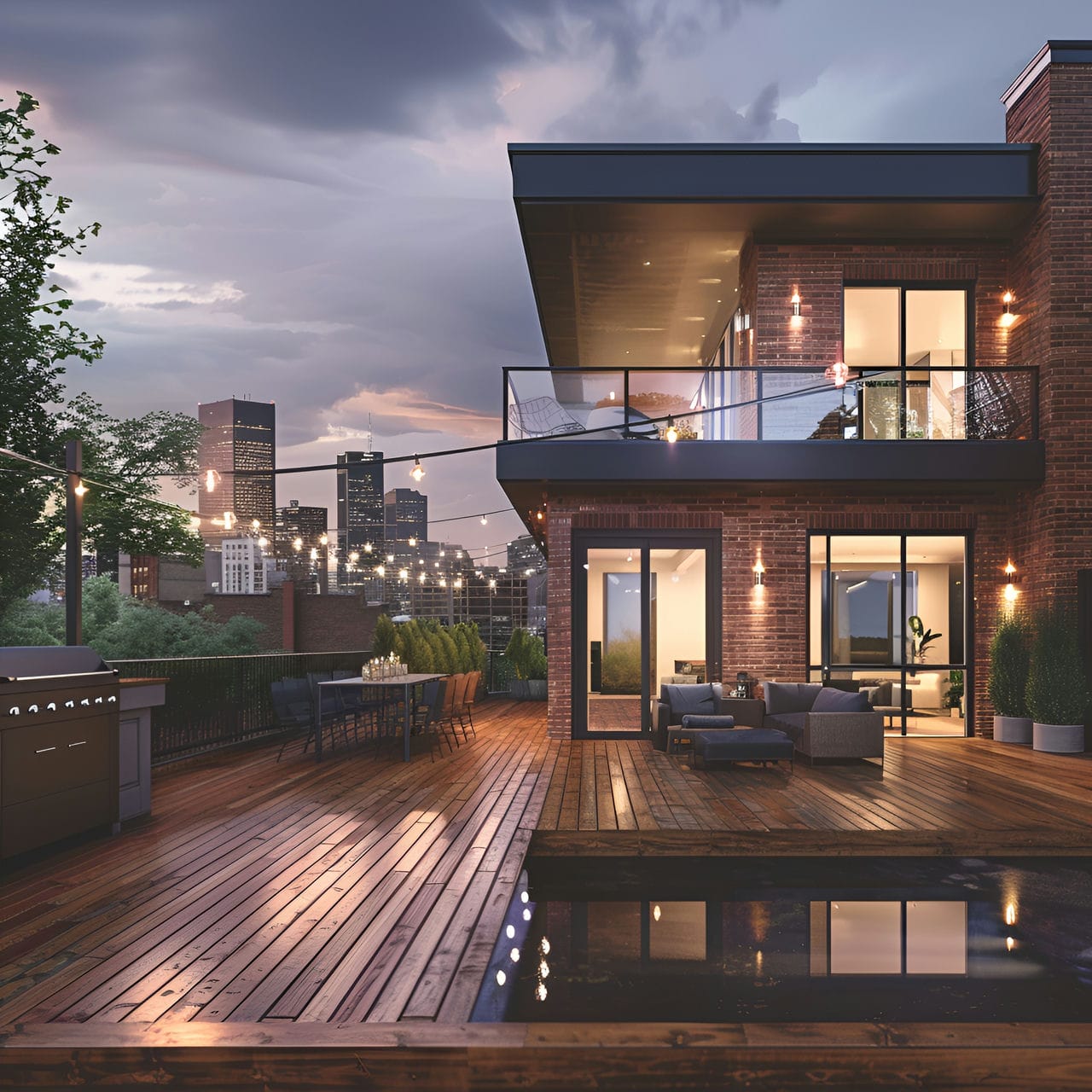
What furniture commonly equips a deck?
Listed below are the types of furniture commonly equip a deck:
- Outdoor dining sets: Outdoor dining sets on a deck are essential for enjoying meals in an open-air environment. These furniture include a table and chairs constructed from weather-resistant materials like aluminum, teak, or synthetic wicker.
- Lounge chairs: Lounge chairs on a deck offer a comfortable spot for relaxation and sunbathing. These furniture include cushions for added comfort and are made from durable materials such as all-weather wicker, teak, or metal. Deck lounge chairs are designed for outdoor leisure, perfect for poolside areas or sun enjoyment.
- Conversation sets: Conversation sets on a deck provide a cozy arrangement for socializing and relaxation. This furniture comprises a small sofa or loveseat, complemented by chairs and a coffee table. Deck conversation sets are designed for outdoor use and made from weather-resistant materials like wicker, aluminum, or wood.
- Side tables: Side tables on a deck are crucial for functionality and convenience. They withstand outdoor conditions and are constructed from metal, glass, or treated wood. These versatile pieces of furniture are easily moved to accommodate different seating arrangements, enhancing the deck’s usability and aesthetic appeal.
- Storage benches: Storage benches on a deck combine seating with practical storage solutions. Made from durable, weather-resistant materials, the furniture provides a space to store cushions, gardening tools, or entertainment supplies. Deck storage benches offer dual functionality, maximizing space efficiency while providing additional seating options.
- Fire pits: Fire pits on a deck are a focal point and provide warmth for outdoor gatherings. They are designed with safety in mind, often including protective screens or barriers. This furniture creates a cozy ambiance, ideal for extending outdoor activities into cooler evenings and adding a touch of luxury to the outdoor living space.
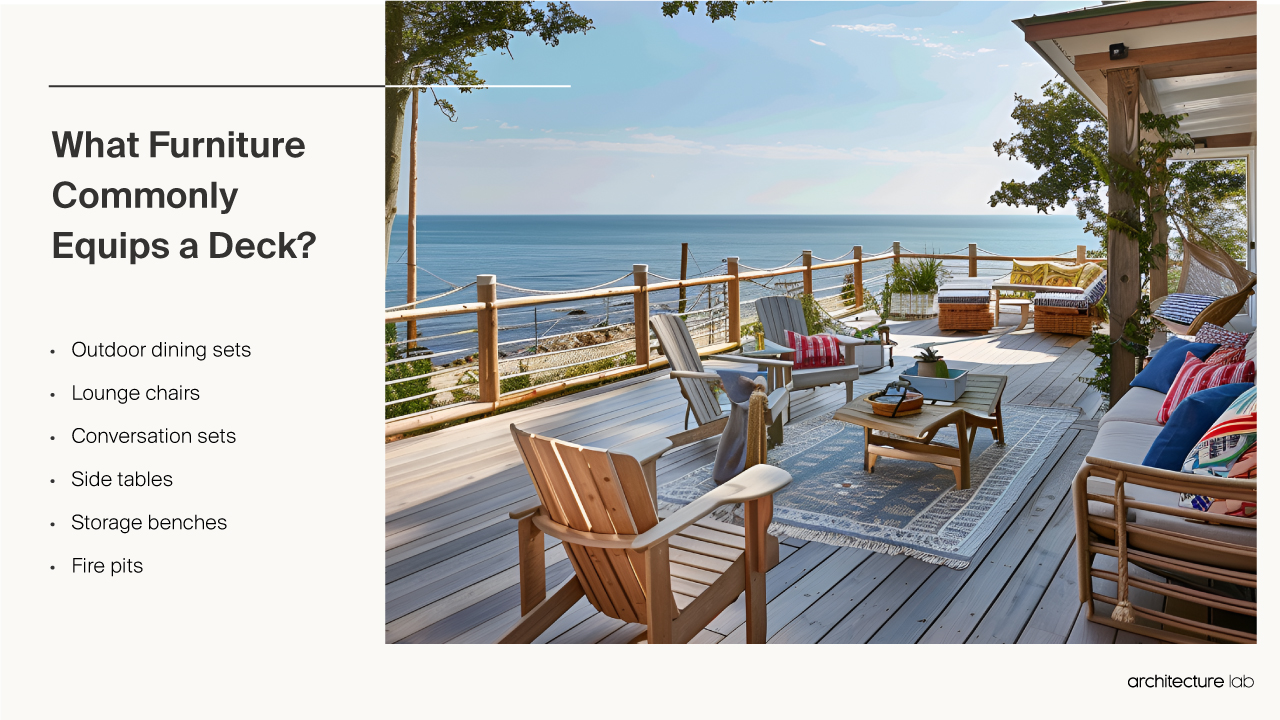
What is the normal ceiling height of a deck?
The normal ceiling height of a deck is 8 feet (2.4 meters) to 9 feet (2.7 meters). Exterior decks do not feature an actual ceiling as they remain open to the outside environment unless covered by an overhead architectural structure. Attached ground floor decks follow residential eave line heights at 8 feet (2.4 meters), where gutters mount averaging 9 feet (2.7 meters) off the deck surface. Optional detachable awning shade systems determine an artificial ceiling height limit starting 8 feet (2.4 meters) up to 10 feet (3 meters) maximum to avoid developing an overly covered roof mass. Positioned third-floor decks with vertical clearance underneath can maintain usable covered headroom up to 9 feet (2.7 meters).
What colors are decks usually painted?
Listed below are the colors usually used in painted decks:
- Blue: Decks feature blue, reflecting the sky and water hues. Shades colors like sky blue, navy, and turquoise are famous for their calming effect and natural association. It pairs well with deck materials like wood or composite, enhancing the aesthetic.
- Gray: Gray colors are common for decks, offering a modern, sleek look. Variants range from light silver to deep charcoal, selected for their versatility and contemporary appeal. Gray complements most outdoor settings and materials, including wood, metal, and stone.
- Green: Green colors in decks bring the essence of nature closer. Shades such as sage, olive, or forest green are chosen for their soothing qualities. Green integrates well with surrounding landscapes.
- Beige: Beige colors are popular in decks for their warm, neutral appearance. Beige provides a subtle backdrop that complements outdoor spaces, from sandy tones to richer taupe. Beige creates a welcoming atmosphere, ideal for outdoor lounging and entertaining.
- White: White colors in decks create a crisp, clean look. Ranging from pure white to off-white, these shades enhance natural light and make spaces feel more open.
- Red: Red colors in decks add vibrancy and energy. Shades like burgundy, cherry, or terracotta are selected for warmth and boldness. Red is an accent color, particularly in furnishings or decor.
- Brown: Brown colors are a natural choice for decks, harmonizing with wooden decking materials. Shades range from light tan to rich mahogany, chosen for their organic and warm qualities. Brown creates a rustic, cozy feel, ideal for outdoor relaxation.
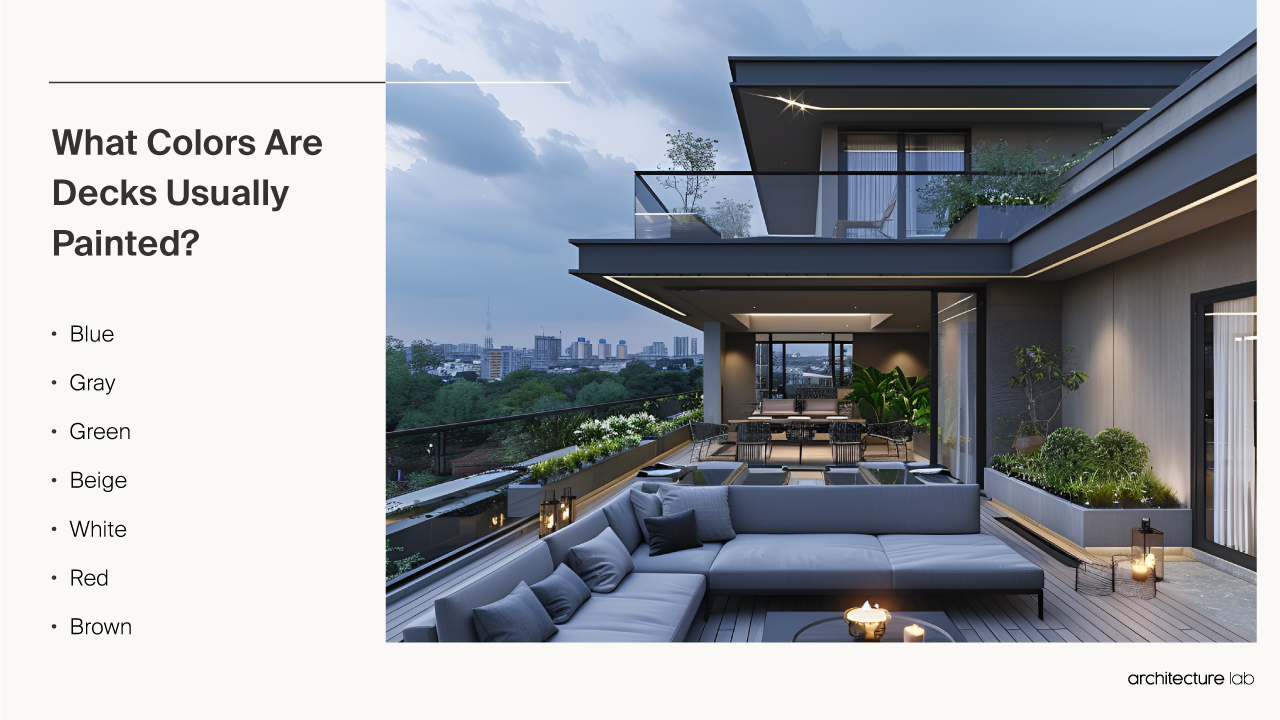
What makes the deck functional?
The deck is functional with a strong and durable structure, robust construction, quality materials, and additional features like lighting, shade structures, and home extension. Firstly, the functionality of a deck is enhanced by its design and layout, which should cater to the intended use, whether for relaxation, dining, or entertainment. The deck should be spacious enough to accommodate furniture and allow easy movement. Secondly, the structural integrity of the deck is paramount. This includes a solid substructure with footings, support posts, beams, joists, and proper hardware to ensure safety and longevity. Thirdly, the surface materials of the deck contribute to its functionality. Durable decking materials like wood or composite can withstand the elements and frequent use. Fourthly, features such as built-in lighting, pergolas for shade, water drainage systems, and storage benches add utility and attractiveness to a deck. Lighting extends the use of the deck into the evening, while pergolas can offer a respite from the sun. Lastly, accessories like planters and fire pits can enhance the ambiance and make the deck more inviting. Planters bring in greenery and can create privacy screens.
How is energy efficiency achieved in a deck?
Energy efficiency is achieved in a deck by using solar panels, energy-efficient lighting, proper insulation, natural ventilation, and energy-efficient heating and cooling systems. Firstly, installing solar panels can be a significant step towards energy efficiency. Solar panels harness the sun’s energy, which is abundant in a greenhouse environment, and convert it into electricity that can be used to power various systems within the greenhouse. Secondly, using energy-efficient lighting, such as LED or solar-powered, can contribute to energy efficiency. These types of lights consume less energy than traditional lighting systems, thus reducing the overall energy consumption in the greenhouse. Thirdly, proper deck insulation can enhance energy efficiency, particularly on the roof. Insulation prevents heat loss, reducing the energy required to maintain optimal temperatures within the greenhouse. Concrete or steel deck insulation can be used to achieve this. Fourthly, using natural ventilation can save significant energy by reducing the need for mechanical ventilation. This can be achieved by designing the greenhouse to allow unrestricted airflow, thereby facilitating the natural cooling and heating of the space. Fifthly, using energy-efficient heating and cooling systems, such as hot deck or cold deck systems, can also contribute to energy efficiency. Lastly, understanding energy use in a greenhouse operation is the first step in reducing energy costs. This involves being conscious of energy expenditures and energy-saving measures, such as using energy-efficient appliances and equipment.
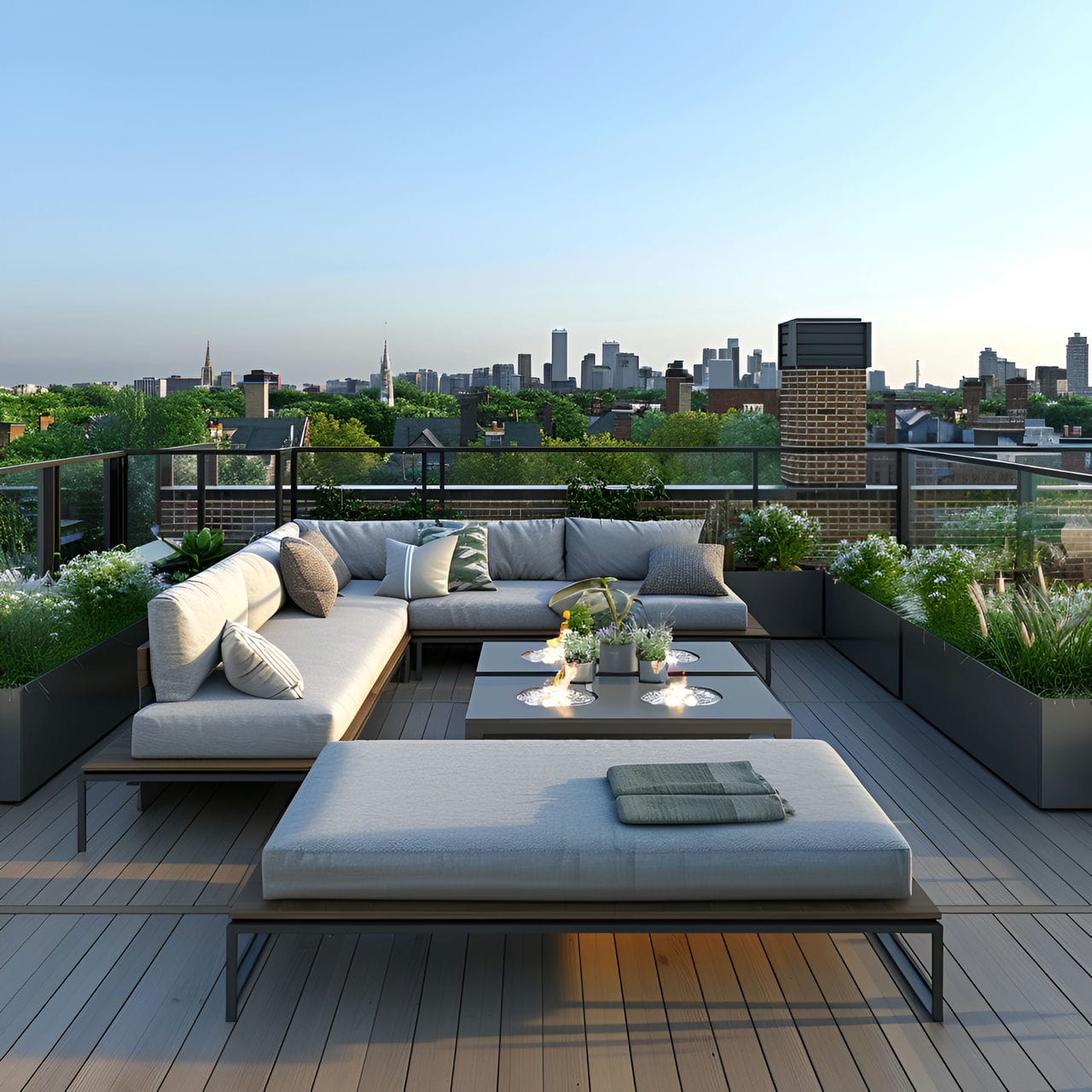
How much does it typically cost to renovate a deck?
The average cost to renovate an existing deck ranging from 175 square feet (16 square meters) to 380 square feet (35 square meters) ranges from $3,000 (€2,700, £2,300) to $15,000 (€13,500, £11,400). Cosmetic updates like neutral stain application or replacing weather-worn boards run closer to $3,000 (€2,700, £2,300). Structural changes like altering layouts or dimensions and foundation upgrades to support hot tubs or pergolas require skilled contractors to drive prices toward $15,000 (€13,500, £11,400). Demolishing and rebuilding decaying framing with treated lumber and hurricane ties could average $5,000 (€4,500, £3,800) alone, while new composite low-maintenance decking increases costs exponentially based on square footage. Adding decorative features like integrated benches, planters, lighting, or weatherproof cabinetry for storage ranges from $2,000 (€1,800, £1,500) to $5,000 (€4,500, £3,800). For high-end contemporary decks with professional kitchens, tempered glass railings, recessed hot tubs, and automated retractable canopy sun shades spanning 300+ square feet (30+ square meters), total transformation budgets exceed $25,000 (€22,500, £18,900). Simple board replacement and stain refresh decks cost $3,000 (€2,700, £2,300) to $7,500 (€6,750, £5,700), while structural overhauls or architectural deck additions match the customization investment required.
What factors affect the deck renovation?
Listed below are the factors that affect the deck renovation:
- Size and layout: The size and design of a deck are crucial in determining the scope of the renovation. Larger decks offer more space for various features, while smaller ones demand efficient utilization. The existing layout influences the possibility of expansion or reconfiguration.
- Materials and durability: The choice of materials is vital in a deck renovation, affecting aesthetics and longevity. Options include wood, composite, and PVC, each with different maintenance needs and durability. Wood decks require regular upkeep but offer a natural look, while composite and PVC provide longevity with less maintenance.
- Railing and safety features: Railings and safety features are key in deck renovations. Railings must comply with local building codes in height and spacing. Material choices for railings, like wood, metal, or glass, contribute to the deck’s overall style and safety. Additional safety features include lighting, non-slip surfaces, or child-proof locks.
- Covering and shade structures: Covering and shade structures impact a deck renovation. Pergolas, awnings, or canopies enhance usability by protecting from sun and rain. The style of these structures can range from simple and functional to elaborate and decorative.
- Landscaping and integration: Landscaping and integration with the surroundings are important in deck renovations. Incorporating planters, built-in benches, or steps to transition to the garden can enhance the deck’s aesthetic appeal.
- Lighting and electrical features: Lighting and electrical features play a significant role in a deck renovation. Proper lighting enhances safety and ambiance, requiring planning for electrical outlets and wiring. Electrical features include outdoor speakers or a kitchen setup.
- Budget and financial constraints: The budget and financial constraints are pivotal in shaping a deck renovation. Financial considerations dictate the scale of the renovation, the choice of materials, and the inclusion of luxury features like outdoor kitchens or fire pits.
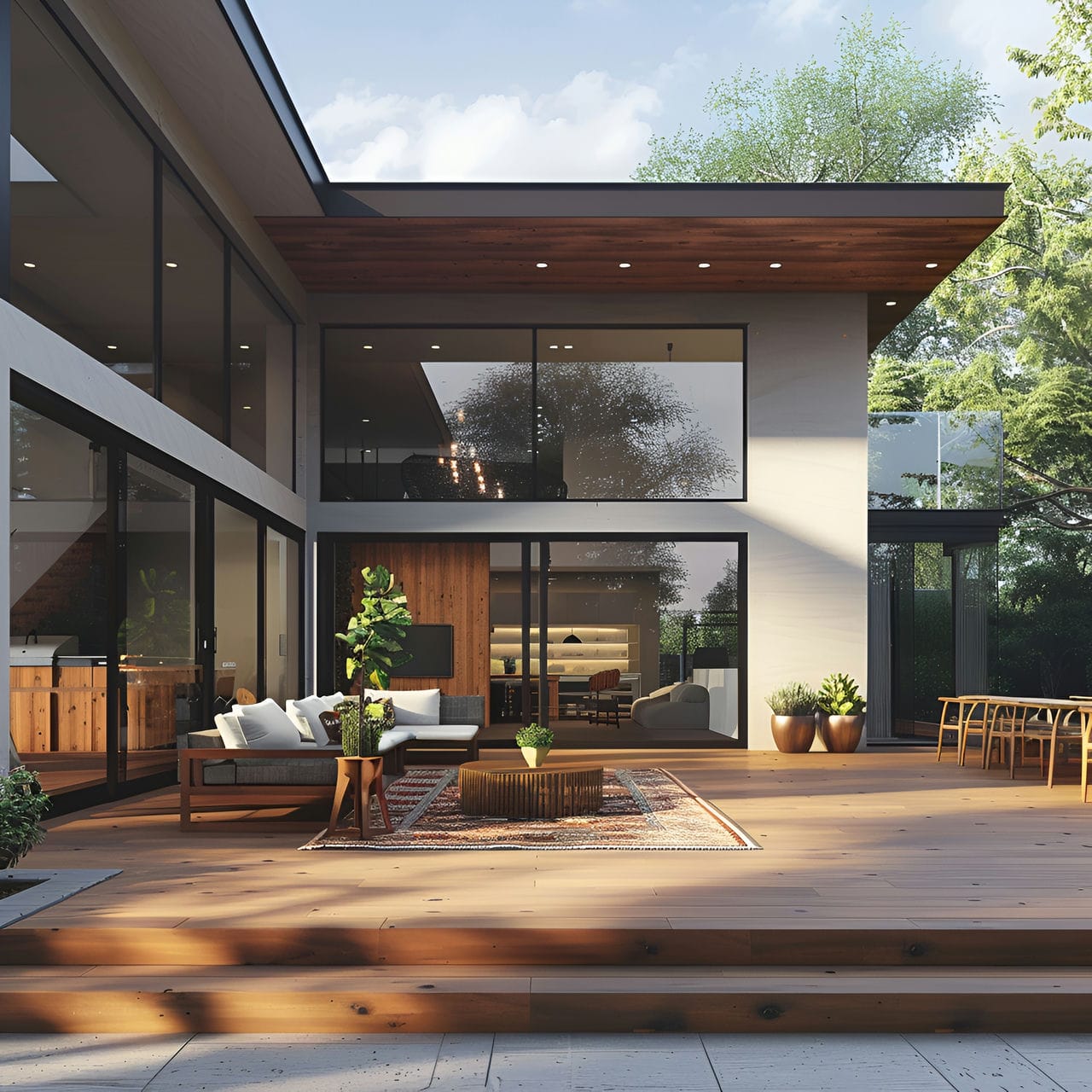
Is an architect required to renovate a deck?
No, an architect is not required to renovate a deck, but it is highly advised to hire one. The expertise of an architect can be invaluable in a deck renovation project. They bring professional design skills that ensure the deck is pleasing, functional, and structurally sound. An architect can creatively address challenges such as space utilization, material selection, and integration with the existing landscape and home. They are proficient in designing decks that complement the house’s architectural style, enhancing the overall property value. Architects deeply understand local building codes and regulations, ensuring the renovation meets all legal requirements.
How can an architect help you upgrade a deck?
Listed below are how an architect can help an owner upgrade a deck:
- Design and layout optimization: An architect can optimize the design and layout of a deck, enhancing its functionality and aesthetic appeal. They assess the existing space and devise a layout that maximizes usability and visual appeal, considering aspects like view, sun exposure, and wind direction.
- Material selection and durability: The suitable materials for a deck upgrade are crucial, and an architect can provide invaluable guidance. They recommend durable, weather-resistant materials that align with the homeowner’s style preferences and budget.
- Lighting and ambiance creation: An architect can design lighting to create the right ambiance for a deck. This might include integrating evening lighting, task lighting for outdoor kitchens or dining areas, and accent lighting to highlight architectural or landscaping features.
- Integration with the home: An architect ensures integration of the deck with the rest of the house. This includes designing transitions between indoor and outdoor spaces, like matching flooring materials or creating accessible pathways.
- Sustainability and eco-friendliness: Architects can incorporate sustainability and eco-friendly features into deck designs. They may use recycled or sustainable materials, design for natural shade to reduce energy usage, or integrate water-efficient landscaping. Sustainable design benefits the environment and can lead to long-term cost savings.
- Permits and regulatory compliance: Navigating permits and regulatory compliance is essential in deck upgrades, and an architect can adeptly manage this process. They understand local zoning laws, building codes, and permit requirements, ensuring the renovation complies with all regulations.
- Project management and contractor coordination: An architect provides comprehensive project management for deck upgrades. They coordinate with contractors, oversee construction, and ensure quality control.
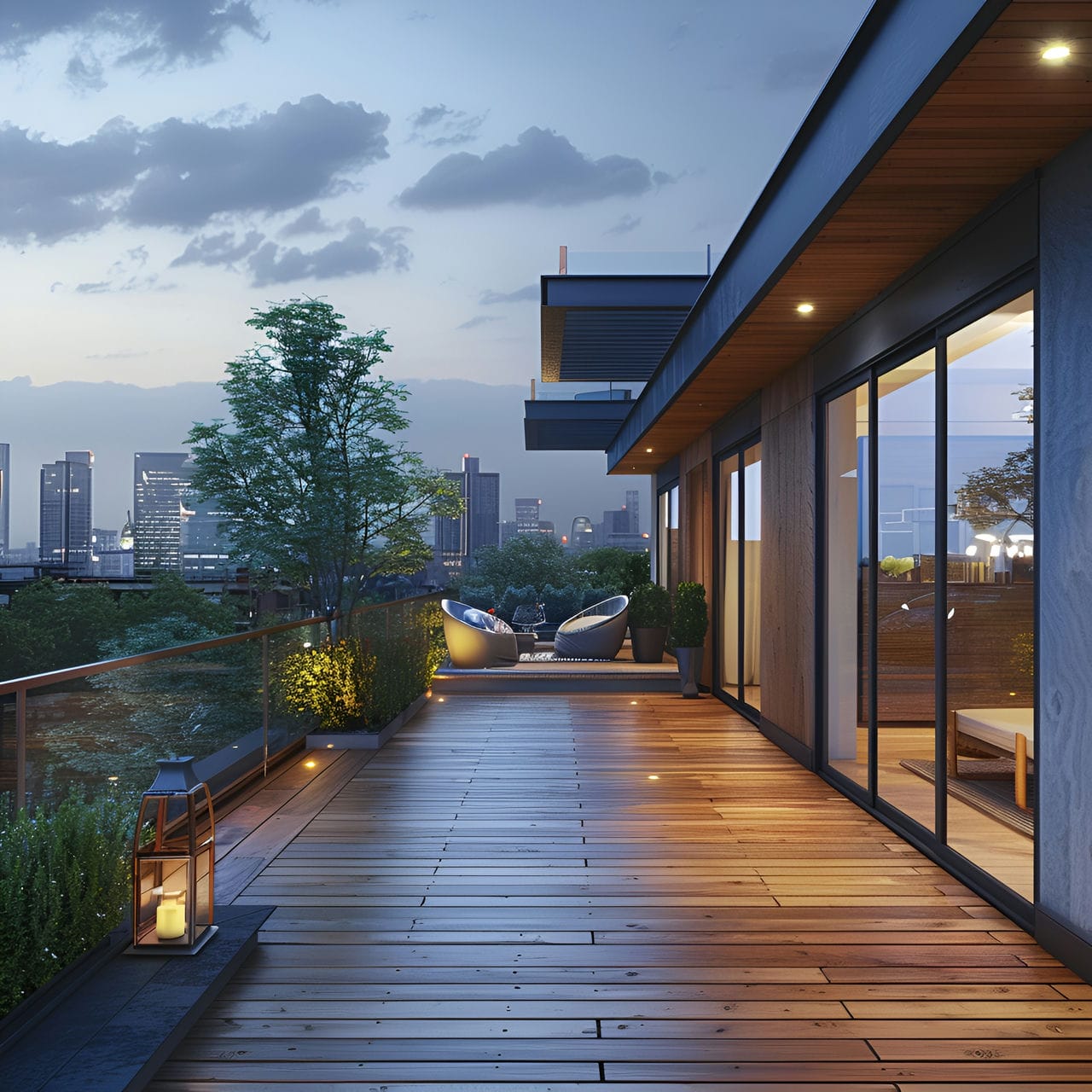
How much does it cost to hire an architect to renovate a deck?
The average cost to hire an architect to renovate a deck renovation ranges from $1,500 (€1,350, £1,150) to $5,000 (€4,500, £3,800). Most architects charge $100 (€90, £75) to $175 (€155, £135) hourly. Adjusting a 270-square-foot (25-square-meter) deck with refreshed neutral stain and simplified LED string lighting may take 10-15 hours, $1,500 (€1,350, £1,150). Reconfiguring a 380-square-foot (35-square-meter) deck area while working within structural parameters by widening staircases for accessibility and adding custom planter boxes or niche storage benches requires 20-30 architectural hours averaging $3,000 (€2,700, £2,300). Top-tier landscape designers collaborate on seamless indoor or outdoor architecture using collapsible glass balcony railing systems, floating canopy covers amid water features, and designer composite decking patterns plus exterior stonework masonry fireplaces charging $5,000 (€4,500, £3,800) or more given engineering coordination spanning 30-50 hours. Typical deck update concepts run $1,500 (€1,350, £1,150) to $3,000 (€2,700, £2,300), while extensive layout redesigns allowing signature luxury living space extensions match customization investments between $3,000 (€2,700, £2,300) and $5,000+ (€4,500+, £3,800+).
Is it worth it to hire an architect to upgrade a deck?
Yes, hiring an architect to upgrade a deck is worth it. An architect brings a wealth of design, functionality, and aesthetic expertise that can transform a deck from a primary outdoor area into a cohesive home extension. They have the skill to creatively address various challenges, such as optimizing the available space, choosing durable and visually appealing materials, and ensuring the deck complements the home’s architectural style. They also know local building codes and regulations, ensuring the deck upgrade meets legal requirements. An architect can manage the project efficiently, coordinating with contractors and overseeing the construction process.
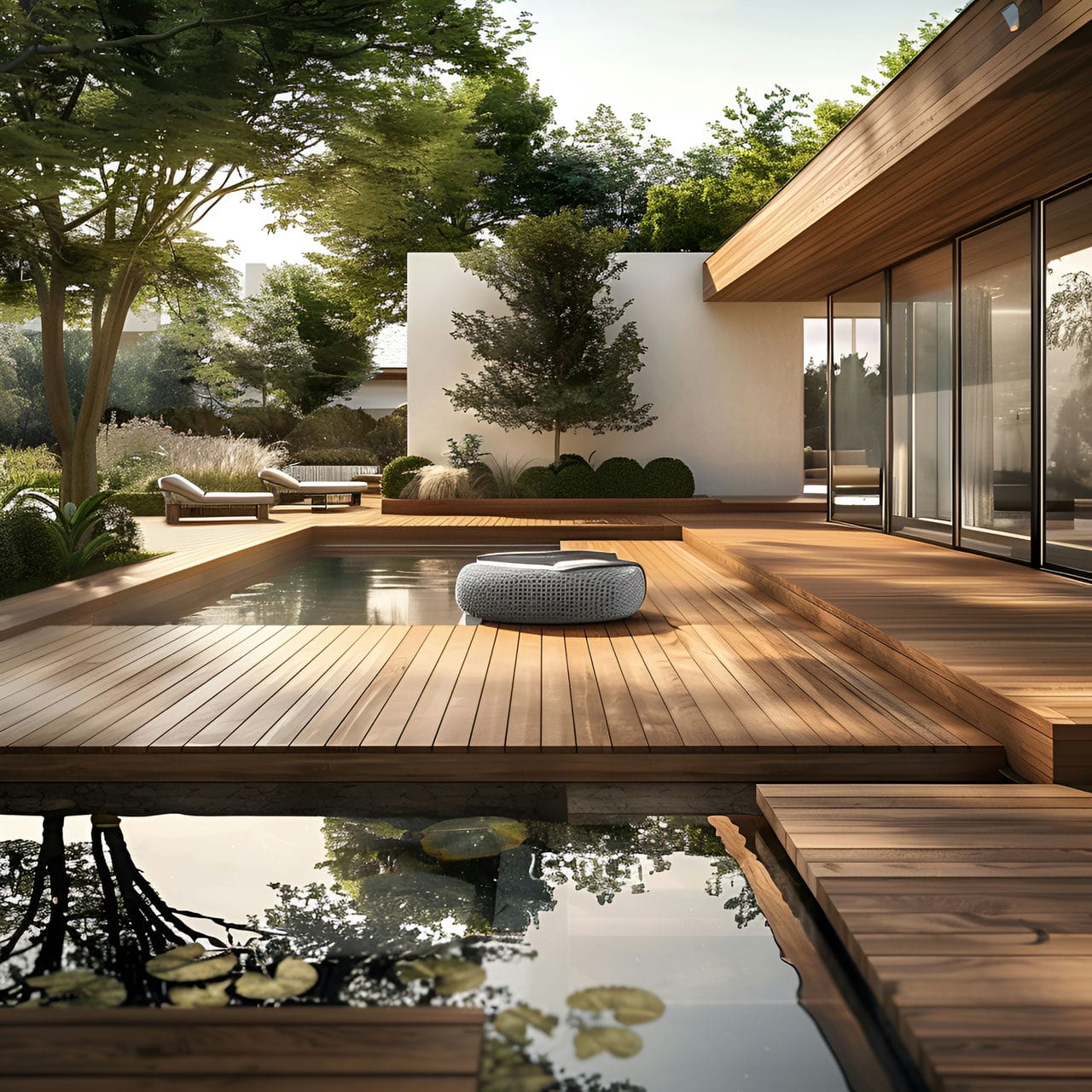
How long is needed to redecorate a deck?
Redecorating a deck requires 2 to 6 weeks. Firstly, the scope of the redecoration plays a significant role. Simple aesthetic changes like repainting or adding new outdoor furniture can be completed relatively quickly. Secondly, the size of the deck is a crucial factor. Larger decks take longer to redecorate due to the increased surface area and potentially more complex design elements. Thirdly, the availability and delivery of materials can impact the timeline. Custom or special-order materials, like unique wood types or specific hardware, might have longer lead times, extending the project duration. Lastly, unforeseen challenges or complications can open the project duration. This might include structural issues during renovation or delays in supply chains.
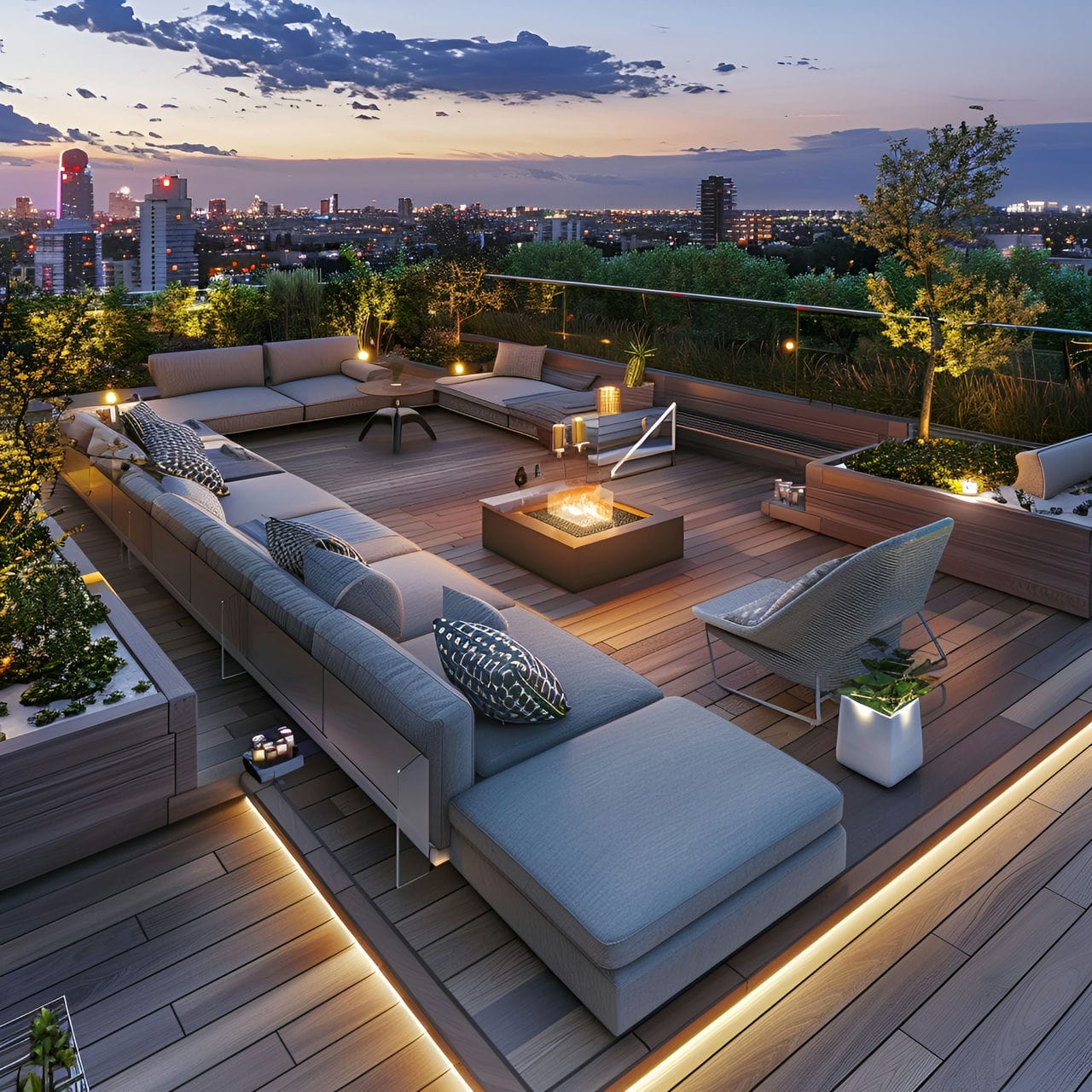
What are the struggles of the homeowner to redecorate a deck?
Listed below are the struggles of the homeowner to redecorate a deck:
- Weatherproofing and durability: Homeowners often need help ensuring weatherproofing and durability when redecorating a deck. Choosing materials that can withstand local weather conditions, such as extreme temperatures, rain, or sun exposure.
- Aesthetic integration with the home: Achieving aesthetic integration of the deck with the existing home is a significant challenge. Homeowners need to ensure that the new design complements the architectural style of their house.
- Functional layout and space utilization: Optimizing the practical layout and space utilization can be complex. Balancing the placement of furniture, plants, and features requires careful planning.
- Selecting and sourcing materials: Homeowners often need help fixing and sourcing suitable materials for deck redecoration. They must find pleasing materials ideal for outdoor use within their budget.
- Balancing budget and quality: Balancing the budget and quality is a common struggle in deck redecoration. High-quality materials and professional craft increase longevity but also cost more.
- Adherence to safety standards: Ensuring adherence to safety standards is crucial for homeowners redecorating a deck. This includes ensuring railings, stairs, and flooring meet local building codes and safety requirements.


